When it comes to buying a printer, there are many brands, types, and models on the market. Canon is a well-known name in the printing industry, and two of its most popular printer types are Inkjet and InkTank printers. Many people wonder, what is the difference between Canon Inkjet and InkTank printers, and which one is right for their needs?
In this article, we will explain the key differences between Canon Inkjet and InkTank printers. Whether you need a printer for work, school, or personal use, understanding these differences will help you make an informed decision and choose the printer that is best suited for your printing needs.
Key Takeaways:
- Canon Inkjet and InkTank printers utilize different printing technologies.
- Canon Inkjet printers use cartridges containing ink and are suitable for various printing needs, including documents and photos.
- InkTank printers have built-in tanks that hold more ink and are ideal for high-volume printing needs.
- Print quality, printing speed, paper handling, cost efficiency, and additional features are all factors to consider when choosing between the two types of printers.
- By evaluating your printing requirements, budget, and long-term cost savings, you can choose the printer that best suits your needs.
Printer Technology
Canon Inkjet printers and InkTank printers use different printing technologies to create high-quality outputs. Understanding these technologies is essential in determining which type of printer suits your specific printing needs.
Inkjet printers work by spraying liquid ink onto paper through tiny nozzles. The ink is delivered through ink cartridges, which need to be replaced when they run out of ink. In contrast, InkTank printers use refillable ink tanks that can hold a larger volume of ink. The ink is pumped from the tanks to the printhead, resulting in lower ink costs per page.
Both types of printers can produce high-quality outputs with vibrant colors and crisp details. However, Canon Inkjet printers are generally more suitable for professional photo printing due to their excellent color reproduction. In contrast, InkTank printers are ideal for high-volume printing, especially in busy offices where frequent cartridge replacements can be costly.
Inkjet printers:
Inkjet printers utilize thermal or piezoelectric technology to heat liquid ink and create tiny droplets that are sprayed onto the paper through nozzles.
| Inkjet Printer Technology | Pros | Cons |
|---|---|---|
| Thermal Inkjet Technology |
|
|
| Piezoelectric Inkjet Technology |
|
|
InkTank printers:
InkTank printers use a continuous ink supply system that delivers ink from large, refillable ink tanks to the printhead through tubes. This system eliminates the need for frequent cartridge replacements and reduces printing costs.
| InkTank Printer Technology | Pros | Cons |
|---|---|---|
| Continuous Ink Supply System |
|
|
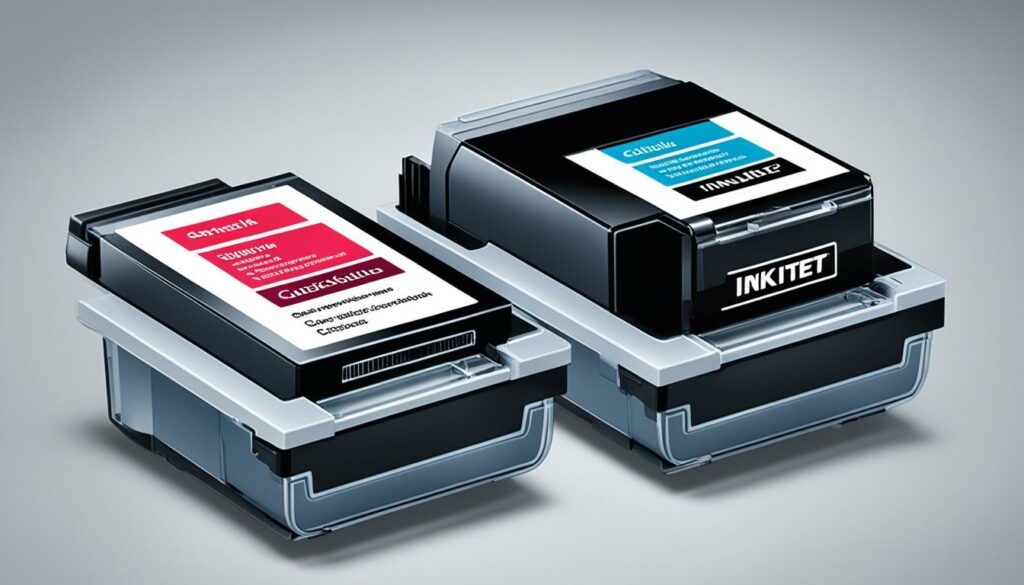
Canon Inkjet Printers
Canon Inkjet printers are the preferred choice of many users who require high-quality outputs and versatile printing capabilities. Unlike other printer types, Canon Inkjet printers use small cartridges filled with liquid ink. This ink is sprayed onto the paper through tiny nozzles, producing sharp and accurate images and texts. Canon Inkjet printers are suitable for both home and office printing, producing high-quality graphics, photos, and documents.
One of the significant advantages of Canon Inkjet printers is their versatility. They can print on an array of paper types and sizes, from plain to glossy or matte, including labels, envelopes, and cardstocks.
The user-friendly features of Canon Inkjet printers make them a popular choice among consumers. They typically offer easy-to-use interfaces or control panels that allow users to scan, copy, and even edit images directly from the printer. In addition, many Canon Inkjet printers come with wireless connectivity options, enabling users to print from their mobile devices anywhere in the house or office.

When it comes to print quality, Canon Inkjet printers are unparalleled. They produce vivid and long-lasting images with highly accurate colors, thanks to their advanced photo printing technologies and ink formulations.
In summary, Canon Inkjet printers are an excellent choice for those who require high-quality prints with versatile capabilities. They are user-friendly and provide various connectivity options to meet the demands of modern printing needs.
InkTank Printers
When it comes to InkTank printers, their defining feature is the built-in ink tanks. Unlike traditional cartridge-based printers, InkTank printers rely on refillable ink tanks that can hold a larger volume of ink. By eliminating the need for frequent cartridge replacements, InkTank printers reduce printing costs significantly.
With InkTank printers, you can expect a continuous supply of ink that lasts much longer than traditional cartridges. This makes them ideal for high-volume printing tasks, such as business reports, photos, and presentations. Furthermore, the cost per page is lower compared to traditional cartridge-based printers, making InkTank printers a more cost-efficient option in the long run.

The Perks of Refillable Ink Tanks:
- Continuous ink supply lasts much longer than traditional cartridges
- Lower cost per page compared to traditional cartridge-based printers
- Reduces the need for frequent cartridge replacements
- Environmentally friendly and reduces plastic waste
InkTank printers are often preferred by businesses and individuals with high printing volume requirements. Additionally, they are a more eco-friendly option, as they reduce plastic waste by eliminating the need for frequent cartridge replacements. Overall, InkTank printers offer a long-lasting, cost-effective, and environmentally friendly printing solution.
Print Quality
When it comes to choosing a printer, print quality is an essential factor to consider. Both Canon Inkjet and InkTank printers can produce high-quality outputs, but Canon Inkjet printers are generally better suited for professional photo printing. They offer vibrant colors and sharper details, making them ideal for printing high-quality photographs.
Additionally, Canon Inkjet printers use smaller ink droplets, offering greater control and precision, resulting in superior print resolution. The technology also allows for a more extensive color gamut, making the prints more accurate and detailed.
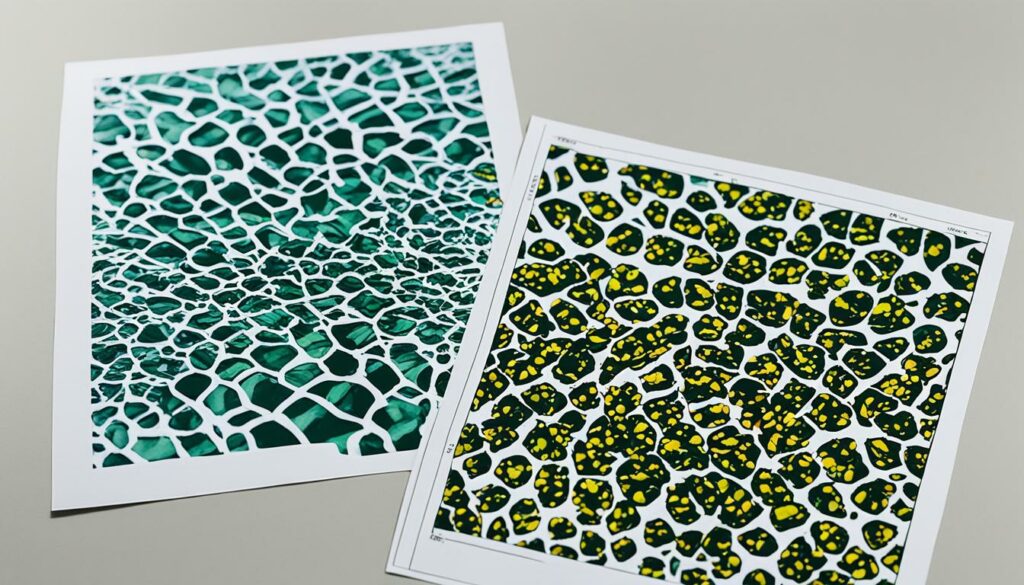
While InkTank printers can also produce excellent print quality, they may have limitations in reproducing vibrant and accurate colors in photos and graphics. However, their strengths lie in producing high-quality text and documents, making them ideal for office or home use.
Printing Speed
Printing speed is an essential consideration when selecting a printer, especially for users who prioritize quick document printing. Canon Inkjet printers have a reputation for their fast printing speeds; they can print high-quality documents at up to 15 pages per minute (ppm). On the other hand, InkTank printers may have slower printing speeds due to their continuous ink supply system. However, the difference in printing speed may not be significant for everyday home or small office use.
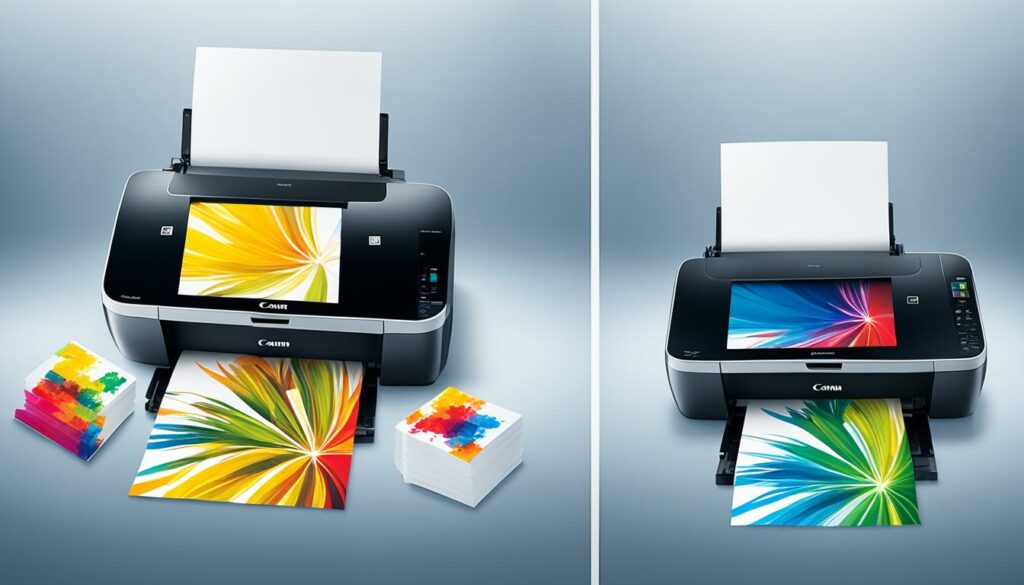
Speed plays an important role in tasks involving high volume printing such as bookkeeping, data analysis, and other work-related tasks. Table 6.1 outlines printing speeds of Canon Inkjet and InkTank printers expressed in pages per minute (ppm), based on the devices' manufacturer specifications.
| Canon Inkjet Printers | InkTank Printers | |
|---|---|---|
| Black & White pages per minute | Up to 15 ppm | Up to 10.5 ppm |
| Color pages per minute | Up to 10 ppm | Up to 5 ppm |
Note: Actual printing speed may vary depending on document complexity, system configuration, software, print mode, and page coverage.
Cost Efficiency
When it comes to choosing a printer, cost efficiency is often a significant factor to consider. While Canon Inkjet printers generally have a lower purchasing cost compared to InkTank printers, long-term savings are possible with InkTank printers due to their refillable ink tanks.
With Canon Inkjet printers, ink is typically sold in small cartridges that need frequent replacement. This replacement cost can add up, making it more expensive per page printed. On the other hand, InkTank printers use refillable ink tanks that can result in a lower cost per page.
If you have high printing requirements, an InkTank printer can save you money over time. While the initial cost may be higher, the savings in ink replacement costs can make up for it in the long run.
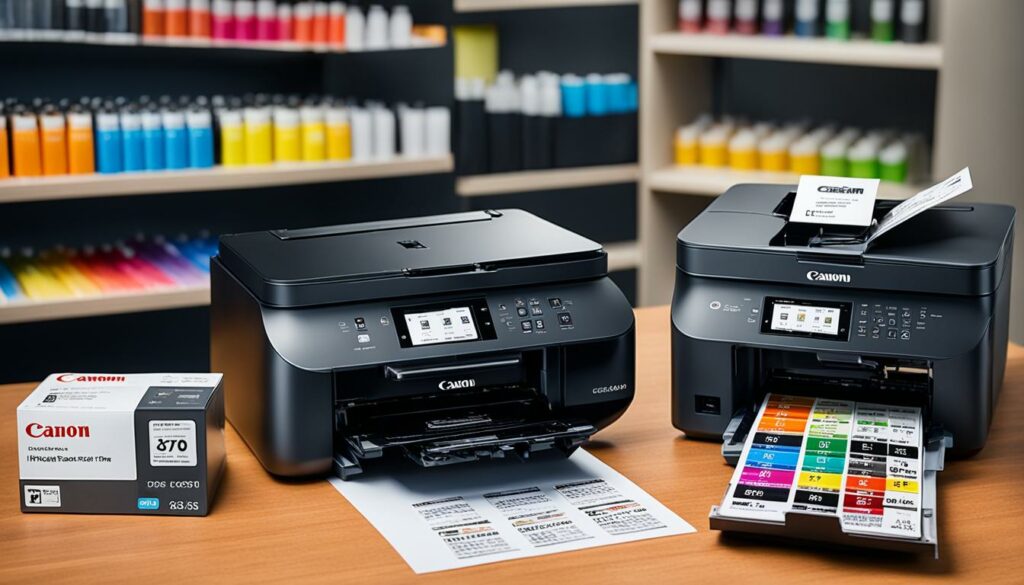
Comparison Table: Cost Efficiency
| Printer Type | Purchasing Cost | Cost per Ink Replacement | Long-Term Savings |
|---|---|---|---|
| Canon Inkjet Printers | Low | High | Less cost-effective over time |
| InkTank Printers | High | Low | More cost-effective over time |
Paper Handling Options
When it comes to paper handling options, Canon Inkjet printers have an edge over InkTank printers. Canon Inkjet printers usually offer a wider range of paper sizes and types, making them suitable for various printing needs. You can use Canon Inkjet printers to print on anything from regular paper to glossy photo paper or even cardstock.
On the other hand, InkTank printers generally have more limited paper handling capabilities and focus mainly on standard paper sizes. However, they still provide enough features for most home or small office needs.
To give you a better idea, here's a breakdown of the paper handling options for Canon Inkjet and InkTank printers:
| Printer Type | Supported Paper Sizes | Supported Paper Types |
|---|---|---|
| Canon Inkjet Printers | Letter, legal, A4, A5, 4×6, 5×7, 8×10, envelope | Plain paper, glossy paper, matte paper, semi-gloss paper, high-resolution paper, photo stickers, T-shirt transfers, magnets, business cards, envelopes |
| InkTank Printers | Letter, legal, A4, A5, 4×6, 5×7, 8×10 | Plain paper, glossy photo paper, semi-gloss photo paper, matte photo paper, presentation paper, envelopes |
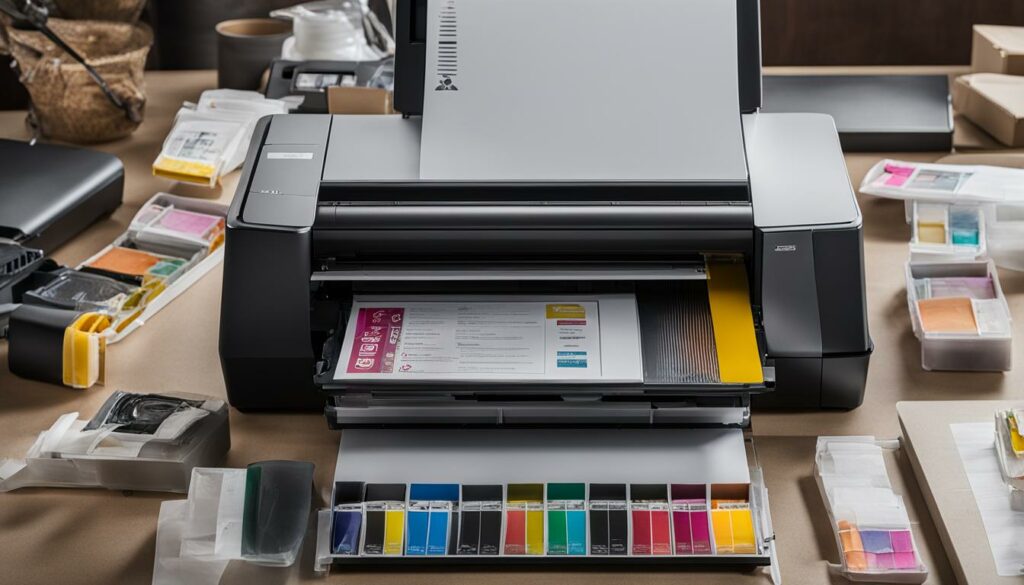
Connectivity and Features
When it comes to connectivity options, both Canon Inkjet and InkTank printers offer similar options, such as USB, Wi-Fi, and mobile printing capabilities. These features allow for easy printing from different devices, including laptops, smartphones, and tablets.
However, Canon Inkjet printers often offer a broader range of additional features, such as touchscreen displays, memory card slots, and automatic document feeders. These features make printing tasks more manageable and efficient, particularly for those who require frequent printing or need to handle larger volumes of printouts.
For example, automatic document feeders enable users to scan multiple pages quickly, while memory card slots allow for direct printing from memory cards without the need for a computer. Additionally, Canon Inkjet printers often come with software suites that enhance functionality, such as Canon Creative Park, a platform that lets users create their own custom paper crafts and printable content.
If additional features are essential for your printing needs, consider opting for a Canon Inkjet printer.
Note: Check the printer specifications carefully, as some InkTank printers may also offer similar additional features, such as touchscreen displays and other advanced functionalities.
Maintenance and Upkeep
Proper maintenance and upkeep are crucial for optimal performance of your Canon Inkjet or InkTank printer. Each type of printer requires specific maintenance, as outlined below.
Canon Inkjet Printers
Canon Inkjet printers generally require more regular maintenance than InkTank printers due to their smaller ink cartridges and nozzles. Printhead cleaning is necessary to ensure that ink flows correctly and to prevent clogging. Consult your printer's manual for specific instructions on how to clean the printhead. Additionally, printhead replacement may be required if your printer isn't printing correctly, even after cleaning.
InkTank Printers
InkTank printers have a more substantial built-in ink supply system, which eliminates the need for regular cartridge replacements. However, they still require occasional cleaning to prevent ink clogging, resulting in uneven ink flow and quality issues. Refer to your printer's manual for specific cleaning instructions, as the process may vary by model.
Regular upkeep, such as keeping your printer clean and dust-free, can also help maintain optimal printer performance. Be sure to follow the manufacturer's guidelines for proper cleaning and care.
Please note, failure to properly maintain your printer can lead to costly repairs or replacement and will decrease the longevity of your printer.
Choosing the Right Printer for Your Needs
When it comes to choosing the right printer for your needs, there are several factors to consider. Both Canon Inkjet and InkTank printers have their advantages, so it's essential to take the time to evaluate these factors and make an informed decision.
Your Printing Requirements
The first consideration is your printing requirements. Do you need a printer for general home use, or do you need a more specialized printer for printing photographs or other high-quality images? Canon Inkjet printers are known for their exceptional photo printing capabilities, while InkTank printers are more suited for high-volume document printing.
Budget
Budget is another critical factor to consider. Canon Inkjet printers are typically cheaper to purchase, while InkTank printers have a higher upfront cost. However, InkTank printers offer significant long-term cost savings as the cost of ink is significantly lower per page.
Print Quality Expectations
If you prioritize print quality, you may want to opt for a Canon Inkjet printer as they are capable of producing exceptional-quality prints with vibrant colors and sharp details. However, InkTank printers also produce high-quality prints and are suitable for general printing needs.
Long-Term Cost Efficiency
As previously mentioned, InkTank printers offer significant cost savings in the long run. If you have high printing requirements, investing in an InkTank printer can save you money over time, making it a cost-efficient choice.
Connectivity and Additional Features
Consider the connectivity options you need, such as Wi-Fi or mobile printing capabilities. Additionally, Canon Inkjet printers often offer additional features such as touchscreen displays, memory card slots, and automatic document feeders. Determine your specific requirements when evaluating the printer's connectivity options and features.
“Remember, choosing the right printer for your needs is about finding a balance between cost, functionality, and print quality.”
By taking the time to evaluate your printing requirements, budget, print quality expectations, and long-term cost efficiency, you can select the printer that best suits your specific needs.
Conclusion
In conclusion, the decision between Canon Inkjet and InkTank printers depends on your specific printing needs and preferences. If you prioritize high-quality photo printing and fast document printing, Canon Inkjet printers may be the better option. However, if you have high printing requirements and prioritize long-term cost efficiency, InkTank printers with refillable ink tanks may be a more suitable choice.
Consider factors such as print quality, printing speed, cost efficiency, paper handling options, and additional features when choosing the right printer for your needs. Both Canon Inkjet and InkTank printers have distinct advantages, so it's important to evaluate these factors carefully.
Overall, the differences between Canon Inkjet and InkTank printers lie in their technology, cost efficiency, maintenance, and print quality. Hopefully, after reading this article, you have a better understanding of which printer technology is best for your needs.

I'm Morgan, the creator of VPNForMe — a site born from too many hours spent side-eyeing sketchy VPN reviews and buffering videos.
I wanted a place where people could get straight answers about privacy, streaming access, and which VPNs actually deliver — without the hype or tech jargon.

